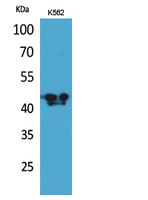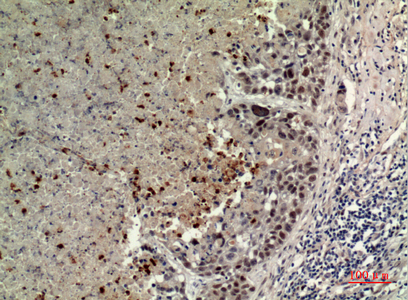ECA39 Polyclonal Antibody
- Catalog No.:YT5443
- Applications:WB;IHC;IF;ELISA
- Reactivity:Human;Mouse;Rat
- Target:
- ECA39
- Fields:
- >>Cysteine and methionine metabolism;>>Valine, leucine and isoleucine degradation;>>Valine, leucine and isoleucine biosynthesis;>>Pantothenate and CoA biosynthesis;>>Metabolic pathways;>>2-Oxocarboxylic acid metabolism;>>Biosynthesis of amino acids;>>Biosynthesis of cofactors
- Gene Name:
- BCAT1
- Protein Name:
- Branched-chain-amino-acid aminotransferase, cytosolic
- Human Gene Id:
- 586
- Human Swiss Prot No:
- P54687
- Mouse Gene Id:
- 12035
- Mouse Swiss Prot No:
- P24288
- Rat Gene Id:
- 29592
- Rat Swiss Prot No:
- P54690
- Immunogen:
- The antiserum was produced against synthesized peptide derived from the Internal region of human BCAT1. AA range:231-280
- Specificity:
- ECA39 Polyclonal Antibody detects endogenous levels of ECA39 protein.
- Formulation:
- Liquid in PBS containing 50% glycerol, 0.5% BSA and 0.02% sodium azide.
- Source:
- Polyclonal, Rabbit,IgG
- Dilution:
- WB 1:500 - 1:2000. IHC: 1:100-1:300. ELISA: 1:20000.. IF 1:50-200
- Purification:
- The antibody was affinity-purified from rabbit antiserum by affinity-chromatography using epitope-specific immunogen.
- Concentration:
- 1 mg/ml
- Storage Stability:
- -15°C to -25°C/1 year(Do not lower than -25°C)
- Other Name:
- BCAT1;BCT1;ECA39;Branched-chain-amino-acid aminotransferase, cytosolic;BCAT(c);Protein ECA39
- Observed Band(KD):
- 43kD
- Background:
- branched chain amino acid transaminase 1(BCAT1) Homo sapiens This gene encodes the cytosolic form of the enzyme branched-chain amino acid transaminase. This enzyme catalyzes the reversible transamination of branched-chain alpha-keto acids to branched-chain L-amino acids essential for cell growth. Two different clinical disorders have been attributed to a defect of branched-chain amino acid transamination: hypervalinemia and hyperleucine-isoleucinemia. As there is also a gene encoding a mitochondrial form of this enzyme, mutations in either gene may contribute to these disorders. Alternatively spliced transcript variants have been described. [provided by RefSeq, May 2010],
- Function:
- catalytic activity:2-oxoglutaric acid + L-isoleucine = (S)-3-methyl-2-oxopentanoic acid + L-glutamic acid.,catalytic activity:2-oxoglutaric acid + L-valine = 3-methyl-2-oxobutanoic acid + L-glutamic acid.,catalytic activity:L-leucine + 2-oxoglutarate = 4-methyl-2-oxopentanoate + L-glutamate.,cofactor:Pyridoxal phosphate.,function:Catalyzes the first reaction in the catabolism of the essential branched chain amino acids leucine, isoleucine, and valine.,similarity:Belongs to the class-IV pyridoxal-phosphate-dependent aminotransferase family.,subunit:Homodimer.,tissue specificity:During embryogenesis, expressed in the brain and kidney. Overexpressed in C-myc induced tumors such as Burkitt's lymphoma.,
- Subcellular Location:
- Cytoplasm.
- Expression:
- During embryogenesis, expressed in the brain and kidney. Overexpressed in MYC-induced tumors such as Burkitt's lymphoma.
- June 19-2018
- WESTERN IMMUNOBLOTTING PROTOCOL
- June 19-2018
- IMMUNOHISTOCHEMISTRY-PARAFFIN PROTOCOL
- June 19-2018
- IMMUNOFLUORESCENCE PROTOCOL
- September 08-2020
- FLOW-CYTOMEYRT-PROTOCOL
- May 20-2022
- Cell-Based ELISA│解您多样本WB检测之困扰
- July 13-2018
- CELL-BASED-ELISA-PROTOCOL-FOR-ACETYL-PROTEIN
- July 13-2018
- CELL-BASED-ELISA-PROTOCOL-FOR-PHOSPHO-PROTEIN
- July 13-2018
- Antibody-FAQs
- Products Images

- Western Blot analysis of K562 cells using ECA39 Polyclonal Antibody. Secondary antibody(catalog#:RS0002) was diluted at 1:20000

- Immunohistochemical analysis of paraffin-embedded human-lung, antibody was diluted at 1:100



